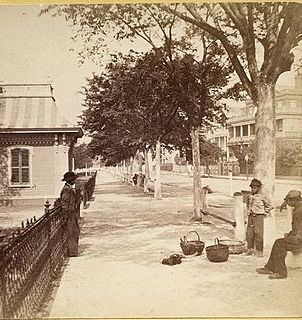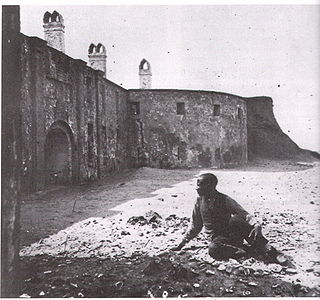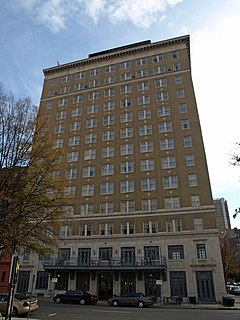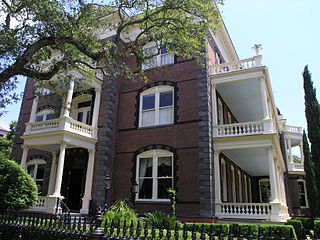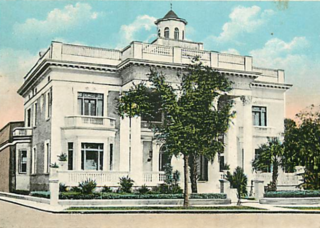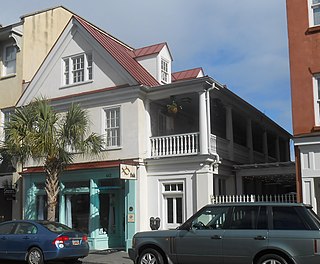
The Fort Sumter Hotel is a seven-story condominium building located at 1 King St., Charleston, South Carolina. Work began on April 1, 1923, and guests were accepted starting in April 1924, but the formal opening was on May 6, 1924. The hotel cost $850,000 to build. [1] The 225-room hotel was designed by G. Lloyd Preacher of Atlanta, Georgia. [2]

Charleston is the oldest and largest city in the U.S. state of South Carolina, the county seat of Charleston County, and the principal city in the Charleston–North Charleston–Summerville Metropolitan Statistical Area. The city lies just south of the geographical midpoint of South Carolina's coastline and is located on Charleston Harbor, an inlet of the Atlantic Ocean formed by the confluence of the Ashley, Cooper, and Wando rivers. Charleston had an estimated population of 134,875 in 2017. The estimated population of the Charleston metropolitan area, comprising Berkeley, Charleston, and Dorchester counties, was 761,155 residents in 2016, the third-largest in the state and the 78th-largest metropolitan statistical area in the United States.

Geoffrey Lloyd Preacher (1882–1972) was an architect prominent in Atlanta, Georgia and the southeastern United States in the design of commercial office, hotel, and apartment buildings.
The hotel was the site of a tryst between John F. Kennedy and a Danish woman with connection to the Nazis. On February 6, 1942, just after Kennedy arrived in Charleston for service with naval intelligence, he spent three nights at the Fort Sumter Hotel with a former Miss Denmark, Inga Arvad. The FBI was monitoring Arvad and taped the encounters. The information was then passed to Kennedy's father, Joseph Kennedy, who, in an effort to separate his son from Arvad, had him reassigned to a PT boat in the Pacific, the now famous PT-109. John F. Kennedy remarked, "They shipped my ass out of town to break us up." [3]

John Fitzgerald "Jack" Kennedy, commonly referred to by his initials JFK, was an American politician and journalist who served as the 35th president of the United States from January 1961 until his assassination in November 1963. He served at the height of the Cold War, and the majority of his presidency dealt with managing relations with the Soviet Union. A member of the Democratic Party, Kennedy represented Massachusetts in the U.S. House of Representatives and Senate prior to becoming president.
Inga Marie Arvad was a Danish journalist, later a U.S. citizen, noted for being a guest of Adolf Hitler at the 1936 Summer Olympics and for her romantic relationship with John F. Kennedy during 1941 and 1942. The juxtaposition of these facts led to suspicions during World War II that she was a Nazi spy. But secret U.S. investigations uncovered no such evidence, and her past did not harm her professional life or social standing in the United States. She was a motion picture writer for Metro-Goldwyn-Mayer in 1945 and a Hollywood gossip columnist, and from the late 1940s until her death she was the wife of wealthy cowboy actor and military officer Tim McCoy.
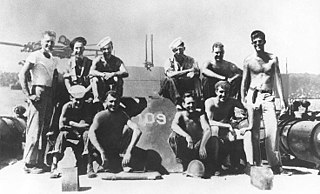
PT-109 was a PT boat last commanded by Lieutenant, junior grade John F. Kennedy, in the Pacific Theater during World War II. Kennedy's actions to save his surviving crew after the sinking of PT-109 made him a war hero. PT-109's collision contributed to Kennedy's long-term back problems and required months of hospitalization at Chelsea Naval hospital. Kennedy's post-war campaigns for elected office referred to his service on the PT-109.
Starting on July 22, 1942, [4] the hotel was used as the headquarters for the sixth naval district for $80,000 per year. [5]
It was refurbished and reopened as a hotel in 1946. [6]
In April 1947, Tennessee Williams and agent Audrey Wood met with Irene Selznick at the Fort Sumter Hotel to discuss her producing his newest play A Streetcar Named Desire (just recently renamed from the original title Poker Night). Tennessee Williams: Mad Pilgrimage of the Flesh by John Lahr, 2014, p. 127.
In 1956, the hotel considered an expansion of 60 to 100 rooms to accommodate the increase in convention business seen in Charleston. [7]
In 1973, the hotel, then operated by Sheraton Hotels, was purchased for $850,000 with plans to convert the building into a condominium project with about 70 units. The condo units were expected to sell from $36,000 to $120,000 for a penthouse unit. The addition of the penthouse units resulted in the creation of an eighth floor, but the change was barely noticeable from outside since it was done by reworking the roof of the building. [8]


